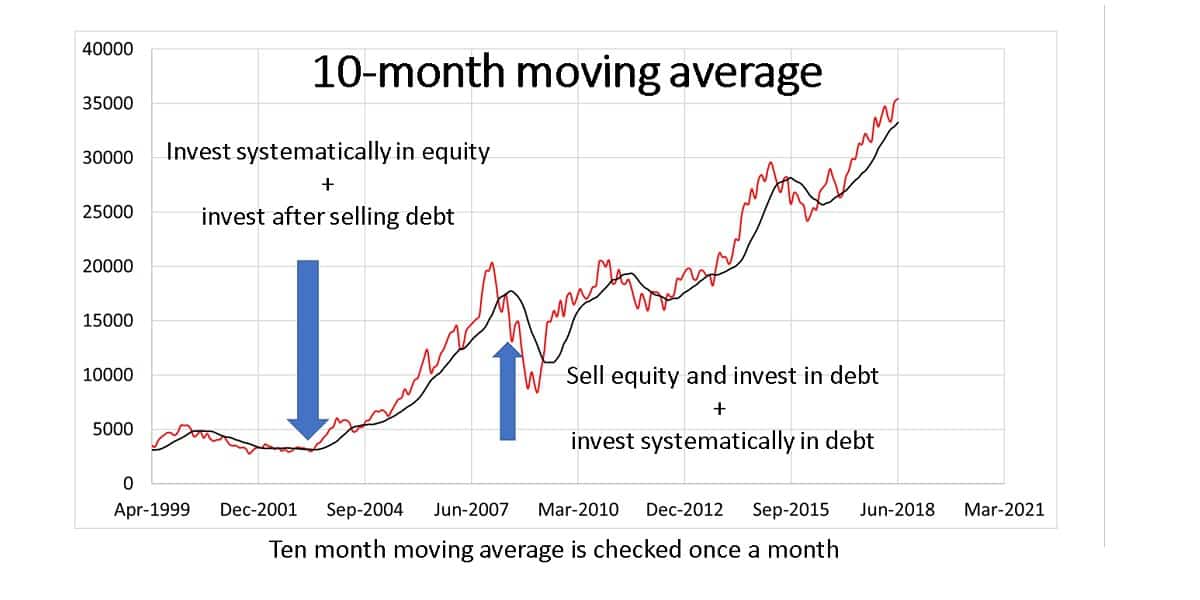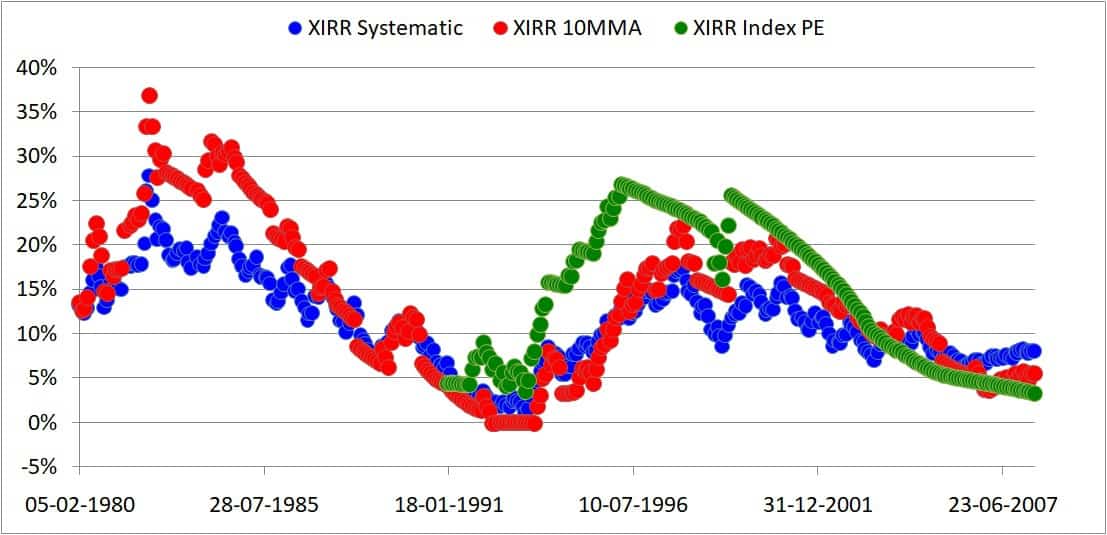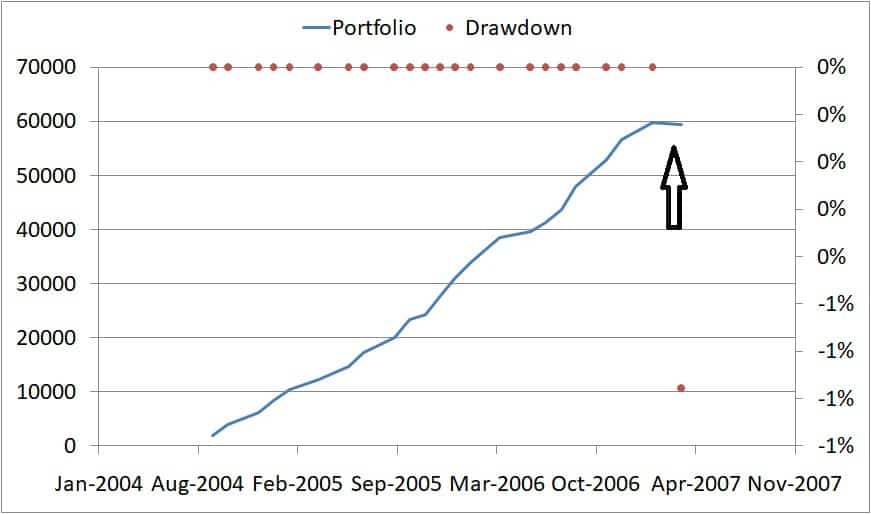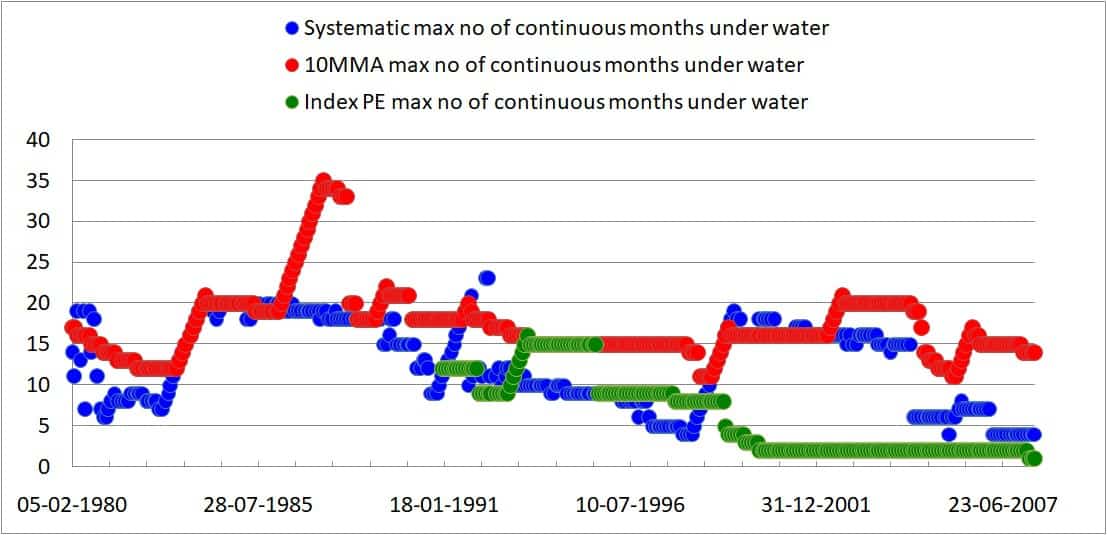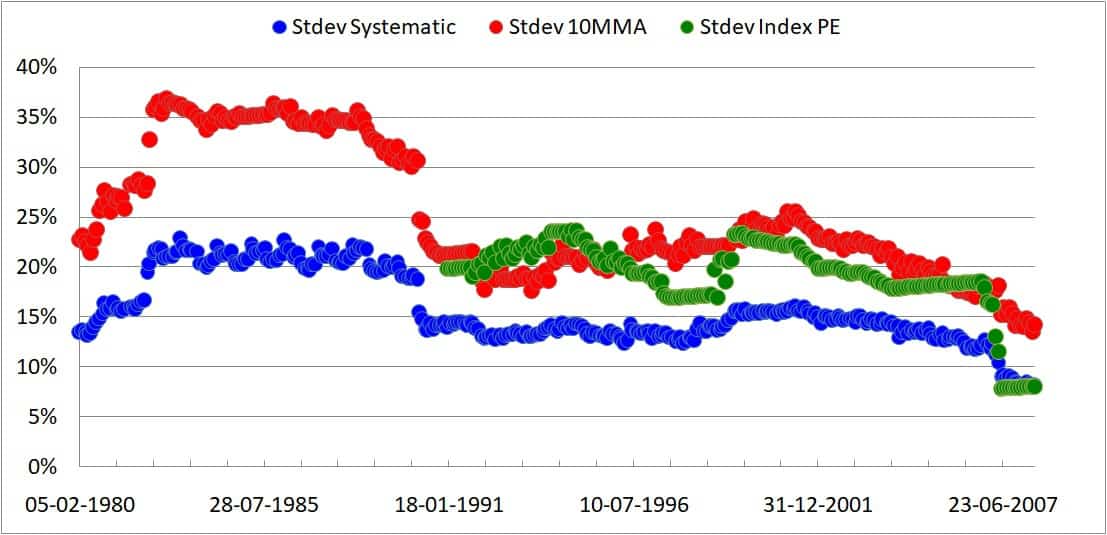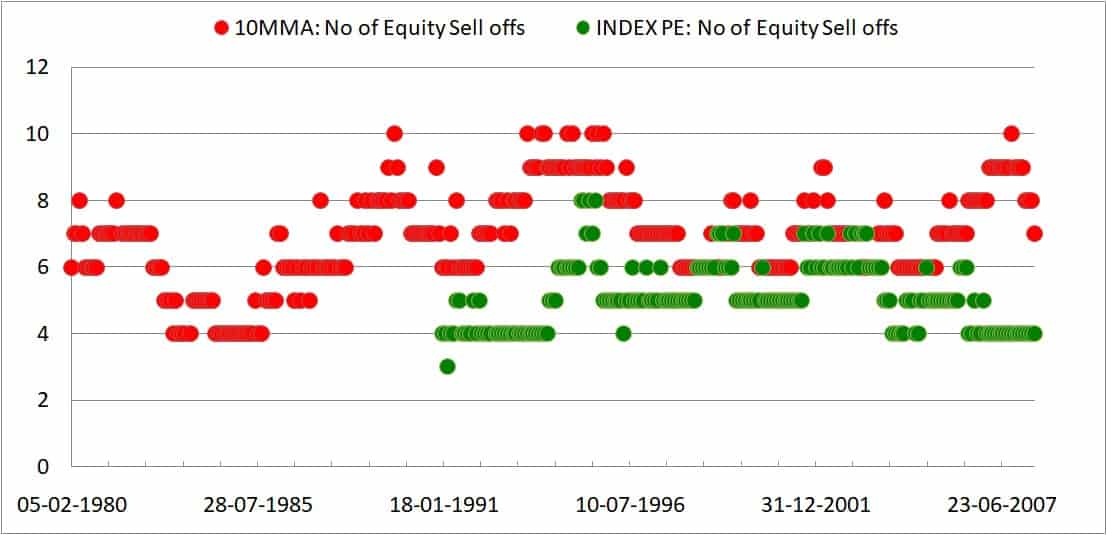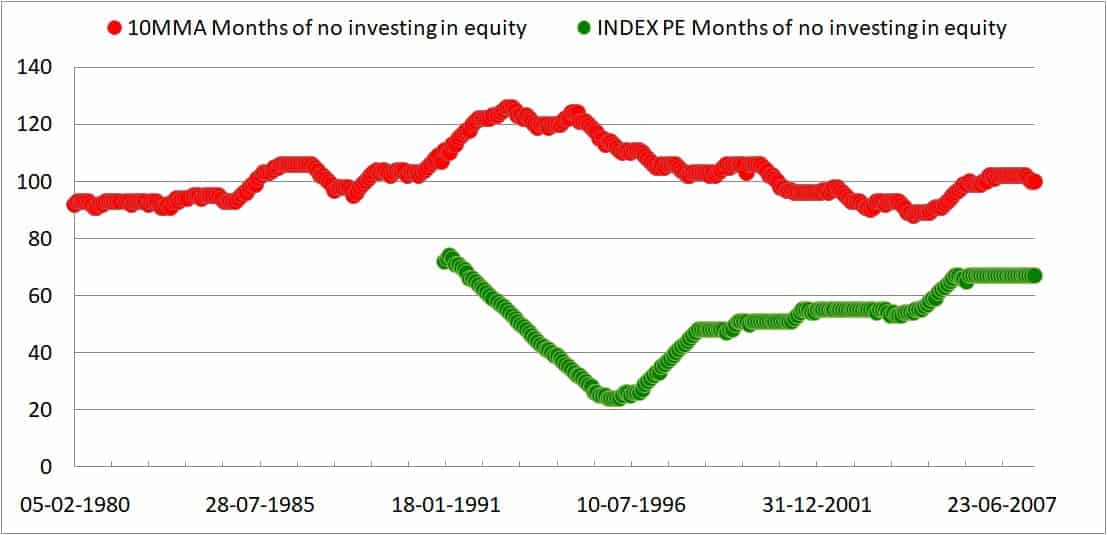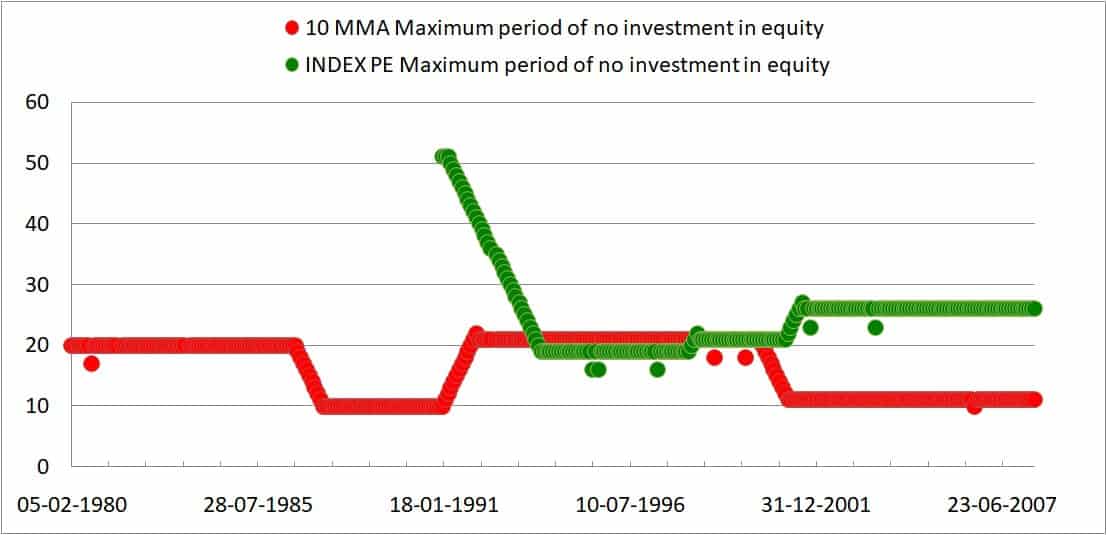Last Updated on December 28, 2021 at 6:47 pm
As mentioned last week, I am starting a new series on tactical asset allocation techniques based on market timing. In this first part, we looked at the index PE (price to earnings ratio) as a buy/sell signal. In the second part, we consider the ten-month moving average (10 MMA) of the Index price.
There are still many aspects of the PE timing model that needs to be considered. We shall get to this over the weekend. Before we begin, please be sure to read and view the disclaimer below.
Warning and Disclaimer
The following is to be treated as investment research based on past data unrepresentative of practical implementation and is not investment advice. They do not factor in behavioural/emotional aspects associated with investing. If you do not know how to understand a backtest result, evaluate its disadvantages, then please, please DO NOT play with your money using market timing. Please watch this video before proceeding further.
What is meant by tactical asset allocation (TAA)?
Asset allocation is the ratio of much equity, fixed income, gold, cash etc. is present in a portfolio. We will only consider equity and fixed income in this study. Tactical asset allocation (TAA) refers to changing these allocations based on certain factors or indicators.
Join 32,000+ readers and get free money management solutions delivered to your inbox! Subscribe to get posts via email! (Link takes you to our email sign-up form)
🔥Want to create a complete financial plan? Learn goal-based investing? Exclusive access to our DIY tools? Increase your income with your skills? Enjoy massive discounts on our robo-advisory tool & courses! 🔥
What is market timing?
It is a technique to reduce portfolio risk and/or enhance portfolio returns by changing asset allocation based on our reading of where the market will head in the near future. This can be the stock market, bond market, gold market etc.
Is tactical asset allocation necessary?
Yes, as the risk associated with a portfolio must be systematically reduced or contained to ensure we have enough money for our future needs.
Is market timing necessary?
No. Tactical asset allocation is necessary and one need not resort to market timing to do this. TAA is possible based on a target corpus associated with a financial goal. See: How to reduce risk in an investment portfolio and Do we need to time the market? The third part of this series is due.
Can we time the market?
Yes. However, realistic and reproducible market timing methods have often primarily reduced risk with or without return enhancement. See results here: Want to time the market with Nifty PE? Learn from Franklin Dynamic PE Fund and here: Is it possible to time the market?
What is a ten-month moving average (10 MMA)?
You take the closing price on the 1st of the previous ten months and average them. Of course, there is nothing special about the first and the average could be taken on any day of the month. You take buy or sell decisions (see below) based on whether the current price is less than or greater than the 10MMA.
Why is an average such as 10MMA used?
Daily market price movements have too many ups and downs. This “noise” makes it difficult to spot price trends. So different types of price averages are used to “smoothen” price movements and spot trends. See the picture below.
How is the 10MMA used?
The 10 MMA is pretty similar to the 200 day moving average. Making investment decisions based on moving averages is known as trend following. If the current price is above the last ten-month moving average, then we expect the future to be bullish and “go all in”. That is 100% equity and 0% fixed income.
If the current price is less than the ten-month moving average then we expect a bearish trend in nurture and exit. That is 0% equity and 100% fixed income. This is summarised in the picture below.
These kinds of investment decisions come under the umbrella of momentum strategies. That is we look for an upward momentum in price and invest and look for a downward momentum and exit. An upward (downward) movement for the last few days to few months can be expected to continue in the near future too. This assumption is the core idea behind a momentum strategy.
Just like the PE method, the 10 MMA also suffers a similar drawback. The price can move above and below the 10 MMA in quick succession. This will lead to frequent buy and sell transactions and is referred to as whipsaw. The idea of taking a moving average over 10 months (an not over a shorter duration) is to reduce this effect.
There is nothing magical or special about 200 days or ten months. You can choose 12 months of 15 months and expect similar results.
Origin of the 10 MMA
Tactical asset allocation (TAA) based on the 10 MMA was popularized by PMS founder and CIO Mebane (Meb) Faber via his paper A Quantitative Approach to Tactical Asset Allocation. This is an easy-to-understand read and I strongly suggest that you try.
Faber constantly updates this strategy via his website. You can also get more details and analysis via extradash. I have also critiqued this strategy before: Is it possible to time the market?
With respect to the US market (which is what I have looked at, but it has been applied to many asset classes and international securities), the method almost always lowers risk with or without higher return. In what follows, I apply a simpler version of the method.
Rules of Market Timing with Ten Month Moving Average
We will compare two portfolios over a ten year investment period.
1: systematic investing into a portfolio of 50% equity and 50% fixed income. An amount of Rs. 1000 will be invested into the Sensex and an imaginary fixed income fund that offers a steady 6% return (this is considered to be a post-tax return). The portfolio will be rebalanced once a year. To account for exit loads and tax associated with this, the final portfolio amount will be reduced by 4%.
2: Tactical investing with the following rules.
Check Index once a month (at the start)
If current price > 10MMA (last ten month price average): Invest Rs. 2000 that month in equity(Sensex). Also, sell fixed income and invest into equity.
The fixed income sale and equity investment are considered to be done on the same day (which is impossible unless they are held as ETFs).
If current price < 10MMA: Invest Rs. 2000 that month in fixed income. Also, sell equity and invest into fixed income.
At this point, you may wish to compare these rules with those used in Market Timing with Index PE Ratio: Tactical Asset Allocation Backtest Part 1. You will notice an important difference.
In the PE-timing model, there was a window when the index PE was neither “low” nor “high”. During these periods, equal amounts (Rs. 1000) was invested in equity and fixed income. Such a window does not exist with the 10MMA. Either you invest Rs. 2000 in equity + amount redeemed from debt or you invest Rs. 2000 in debt + amount redeemed from equity.
The final tactical portfolio is reduced by 20% (this is 5 times the amount assumed for the systematic portfolio as the average no of trades in 10Y is about 5). This 20% accounts for exit loads of equity and fixed income and tax associated with equity. Remember equity was taxed like a debt fund before 2004 and will be again taxed from the current FY. The tax associated with fixed income is already accounted for in its returns (constant 6%).
At first sight, 20% may look a bit much, but you may change your mind when you see results below. Anyway, it is better to err on the side of caution. I hope these assumptions are reasonable. A market-linked fixed income security would have been better, but let us work with these for a start. Pre-tax returns of 8%+ were easily attainable up until 2014 or so. Therefore I think 6% post-tax is reasonable for the backtest.
Market Timing with 10 MMA: Results
In what follows, I also include the PE-timing results for comparison.
Portfolio Returns (XIRR)
The systematic and 10MMA portfolios were tested for 338 past ten-year periods and the PE model was compared for 209 periods with same investment dates. Both models were successful in getting a higher return for some periods. I do not want to get into numbers here (how many runs were successful) as that is often misinterpreted as a probability.
No of months underwater
Next, we consider the total no of months the portfolios were underwater. That is the no of months the portfolio was lower than a previous peak. This is known as a drawdown. Here is an example.
Notice the drawdown points on the left. The first time the portfolio dips from a peak the drawdown is -1% (non-zero). So that is the first month underwater. We calculate the total number of such months the portfolio was lower than a previous peak (underwater)
Clearly, the index PE method is better (for the period studied). It has lower falls from a peak (I am referring to the portfolio here). The systematic method is typically better than the 10MMA too.
No of months continuously underwater
Now consider this example. Notice that within the rectangular area, the portfolio was always lower than its most recent peak. So the drawdowns (falls) calculated each month (red dots) within the box were negative. This means the portfolio was continuously underwater for 11 months.
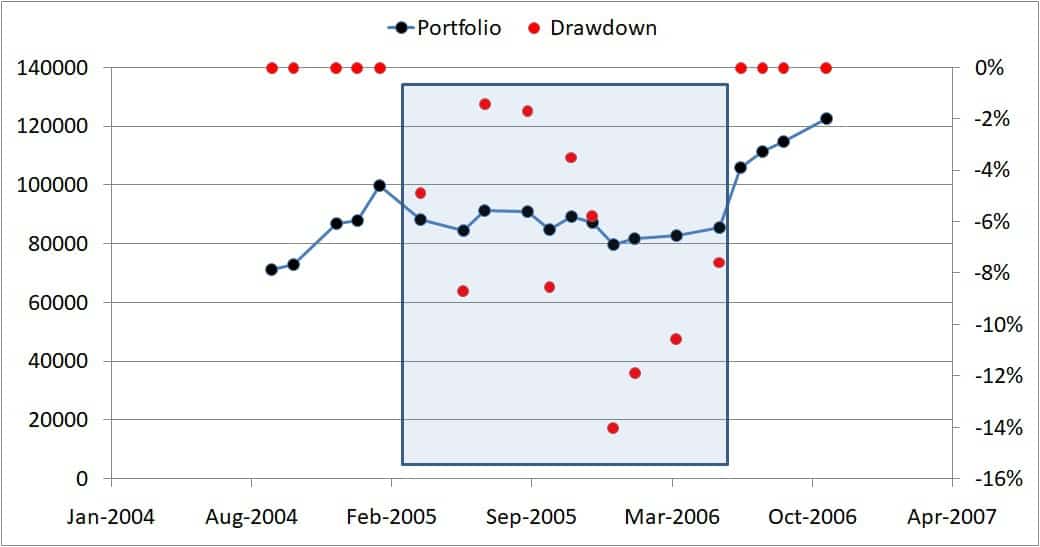
So we ask, during each run, what the most no of months the portfolio was continuously underwater.
The PE method is better here too.
Maximum fall from peak (max drawdown)
So we next ask during each run what was the biggest fall from a pealk (drawdown)
Generally, both timing models had steeper falls (the vertical axis is negative). A -40% drawdown means a -40% fall from a peak from one month to the next.
Volatility comparison
This is the average spread (standard deviation) in the month to month portfolio returns. Higher the value, higher the portfolio ups and downs.
Since the equity allocation swings from 100% to 0% in both timing models, we can expect higher volatility. There is not much to differentiate the two models.
No of equity trades (sell-offs)
The 10MMA strategy seems to requires more equity sell-offs than the Index PE model. Though both are reasonable. In spite of this, I have used the same 20% discounting factor for both models. If we recognise that 10MMA could entail higher taxes and loads, the PE model (at least the one considered) would be a better bet.
Months of investment in equity
Since the 10MMA model is a bit extreme when it comes to equity invest (either all or nothing) as mentioned above, it results in a higher no of months with no equity investment. Behaviourally it requires more discipline.
Max continuous period of no equity investment
Amusingly here the 10MMA is a bit more steady with the max period of no investment between 10 and 20 months. The PE model requires long stretches of no investment.
Summary
Did you come up to this point sequentially? Then thank you. Let me know if any of the above is not clear and leave your comments below. If there are any other strategy that you want tested, I will be happy to try.
Did you come straight to this without bothering to study any of the above graphs? Then, sorry, I will not cater to lazy readers and give a nice, “this is better than that” summary. Go back up and figure that out yourself or ignore this article altogether.
Remember Market timing needs a whole lot more discipline than setting up a SIP. Market timing is therefore pretty boring!
Will I adopt this strategy? No, because I don’t need to. I can manage risk with my goal targets. Also, I cannot stay away from equity investing for this long.
Should you adopt this strategy? Not my problem. You will have to figure it out.
Does this strategy work? The backtest says yes but keep in mind the assumptions made, real-life limitations, the fact that in the recent past results are not that good and that it is only a back-test.
Note: I will not answer any personalized question regarding this strategy. Also, the excel sheet used will not be shared. I consider it a proprietary research tool and will not share it until I milk it dry.
🔥Enjoy massive discounts on our courses, robo-advisory tool and exclusive investor circle! 🔥& join our community of 7000+ users!
Use our Robo-advisory Tool for a start-to-finish financial plan! ⇐ More than 2,500 investors and advisors use this!
Track your mutual funds and stock investments with this Google Sheet!
We also publish monthly equity mutual funds, debt and hybrid mutual funds, index funds and ETF screeners and momentum, low-volatility stock screeners.





- Do you have a comment about the above article? Reach out to us on Twitter: @freefincal or @pattufreefincal
- Have a question? Subscribe to our newsletter using the form below.
- Hit 'reply' to any email from us! We do not offer personalized investment advice. We can write a detailed article without mentioning your name if you have a generic question.
Join 32,000+ readers and get free money management solutions delivered to your inbox! Subscribe to get posts via email! (Link takes you to our email sign-up form)
About The Author
 Dr M. Pattabiraman(PhD) is the founder, managing editor and primary author of freefincal. He is an associate professor at the Indian Institute of Technology, Madras. He has over ten years of experience publishing news analysis, research and financial product development. Connect with him via Twitter(X), Linkedin, or YouTube. Pattabiraman has co-authored three print books: (1) You can be rich too with goal-based investing (CNBC TV18) for DIY investors. (2) Gamechanger for young earners. (3) Chinchu Gets a Superpower! for kids. He has also written seven other free e-books on various money management topics. He is a patron and co-founder of “Fee-only India,” an organisation promoting unbiased, commission-free investment advice.
Dr M. Pattabiraman(PhD) is the founder, managing editor and primary author of freefincal. He is an associate professor at the Indian Institute of Technology, Madras. He has over ten years of experience publishing news analysis, research and financial product development. Connect with him via Twitter(X), Linkedin, or YouTube. Pattabiraman has co-authored three print books: (1) You can be rich too with goal-based investing (CNBC TV18) for DIY investors. (2) Gamechanger for young earners. (3) Chinchu Gets a Superpower! for kids. He has also written seven other free e-books on various money management topics. He is a patron and co-founder of “Fee-only India,” an organisation promoting unbiased, commission-free investment advice.Our flagship course! Learn to manage your portfolio like a pro to achieve your goals regardless of market conditions! ⇐ More than 3,000 investors and advisors are part of our exclusive community! Get clarity on how to plan for your goals and achieve the necessary corpus no matter the market condition is!! Watch the first lecture for free! One-time payment! No recurring fees! Life-long access to videos! Reduce fear, uncertainty and doubt while investing! Learn how to plan for your goals before and after retirement with confidence.
Our new course! Increase your income by getting people to pay for your skills! ⇐ More than 700 salaried employees, entrepreneurs and financial advisors are part of our exclusive community! Learn how to get people to pay for your skills! Whether you are a professional or small business owner who wants more clients via online visibility or a salaried person wanting a side income or passive income, we will show you how to achieve this by showcasing your skills and building a community that trusts and pays you! (watch 1st lecture for free). One-time payment! No recurring fees! Life-long access to videos!
Our new book for kids: “Chinchu Gets a Superpower!” is now available!


Must-read book even for adults! This is something that every parent should teach their kids right from their young age. The importance of money management and decision making based on their wants and needs. Very nicely written in simple terms. - Arun.Buy the book: Chinchu gets a superpower for your child!
How to profit from content writing: Our new ebook is for those interested in getting side income via content writing. It is available at a 50% discount for Rs. 500 only!
Do you want to check if the market is overvalued or undervalued? Use our market valuation tool (it will work with any index!), or get the Tactical Buy/Sell timing tool!
We publish monthly mutual fund screeners and momentum, low-volatility stock screeners.
About freefincal & its content policy. Freefincal is a News Media Organization dedicated to providing original analysis, reports, reviews and insights on mutual funds, stocks, investing, retirement and personal finance developments. We do so without conflict of interest and bias. Follow us on Google News. Freefincal serves more than three million readers a year (5 million page views) with articles based only on factual information and detailed analysis by its authors. All statements made will be verified with credible and knowledgeable sources before publication. Freefincal does not publish paid articles, promotions, PR, satire or opinions without data. All opinions will be inferences backed by verifiable, reproducible evidence/data. Contact information: To get in touch, use this contact form. (Sponsored posts or paid collaborations will not be entertained.)
Connect with us on social media
- Twitter @freefincal
- Subscribe to our YouTube Videos
- Posts feed via Feedburner.
Our publications
You Can Be Rich Too with Goal-Based Investing
 Published by CNBC TV18, this book is meant to help you ask the right questions and seek the correct answers, and since it comes with nine online calculators, you can also create custom solutions for your lifestyle! Get it now.
Published by CNBC TV18, this book is meant to help you ask the right questions and seek the correct answers, and since it comes with nine online calculators, you can also create custom solutions for your lifestyle! Get it now.Gamechanger: Forget Startups, Join Corporate & Still Live the Rich Life You Want
 This book is meant for young earners to get their basics right from day one! It will also help you travel to exotic places at a low cost! Get it or gift it to a young earner.
This book is meant for young earners to get their basics right from day one! It will also help you travel to exotic places at a low cost! Get it or gift it to a young earner.Your Ultimate Guide to Travel
 This is an in-depth dive into vacation planning, finding cheap flights, budget accommodation, what to do when travelling, and how travelling slowly is better financially and psychologically, with links to the web pages and hand-holding at every step. Get the pdf for Rs 300 (instant download)
This is an in-depth dive into vacation planning, finding cheap flights, budget accommodation, what to do when travelling, and how travelling slowly is better financially and psychologically, with links to the web pages and hand-holding at every step. Get the pdf for Rs 300 (instant download)